Airborne Wireless
The plane may be ready for takeoff, but for many passengers, lifting off the tarmac means being sucked into a holding pattern known as the cybervoid. For the Internet addicted, a four-hour coast-to-coast flight is made interminable by the absence of e-mail and web access.
Thanks to Aircell, that’s about to change.
“Our mission is dirt simple,” says Jack Blumenstein, Aircell’s CEO. “We let people do the things that they like to do in an Internet session — and are nearly addicted to doing on the ground — in the air.”
No fledgling startup, the Itasca, Ill., company creates communication systems for business and commercial aircraft. After 17 years, its lineup of services now includes broadband communication systems for the airline industry.
Aircell has deals in place with American Airlines, Delta Air Lines and Virgin America to offer broadband Internet service on board their domestic flights by year’s end. American is testing the Aircell system on all 15 of its 767-200 transcontinental aircraft, which fly from JFK International Airport in New York to Los Angeles, Miami and San Francisco, carrying about 170 passengers per flight. Virgin and Delta also plan to equip their entire domestic fleets with Aircell’s wireless broadband service.
For passengers, in-flight connectivity could mean either an end to boredom or a boost in productivity, and that could result in improved customer satisfaction. The service is also an important way to differentiate one airline from its unconnected cousins, especially at a time when the major air carriers are struggling with a deadly combo of higher ticket prices and what many consumers perceive as downgraded in-flight services.
“Airlines with this capability will steal market share from those that don’t have it, and they will have a competitive business advantage over those with no stated Internet option,” says Henry H. Harteveldt, vice president and principal airline analyst at Forrester Research. “This is one of the few services airlines can charge for with no push back from customers,” he says.
According to Forrester, 39 percent of passengers are willing to pay more for noticeably better travel products or services. And the longer the flight, the more passengers want Internet access. For flights of less than one hour, only 9 percent of passengers report being extremely interested in accessing the Internet. On flights of four hours or more, the interest level quadruples, to 36 percent.
What Took So Long?
In-flight broadband isn’t a new idea. In fact, before Aircell, several of the major U.S. carriers such as United Airlines, Delta and American partnered with Boeing to provide in-flight Internet. But in the wake of the terrorist attacks in 2001, the airlines sidelined the project to focus on staying out of Chapter 11.
After a $1 billion investment in the technology, Boeing discontinued its Connexion service two years ago. While several European and Asian carriers such as Japan, Lufthansa and Singapore airlines offered the service, Boeing never launched it on any domestic carriers. The cost to outfit each plane: $500,000.
![]()
If it were available, would you or your company use a wireless broadband service on an airplane for your employees who travel on business?
56% Yes, if the price is reasonable
31% No, the technology is not necessary.
7% We have no employees who travel for business.
4% Don't know
2% Yes, regardless of the price
Aircell’s Blumenstein says his company’s air-to-ground broadband system, called Gogo Inflight Internet, won’t suffer the same fate.
“The approach that Boeing took produced a service people liked, but the economic model did not work. It required 1,000 pounds of equipment and an antenna the size of a surfboard, and the airline had to take the airplane out of service,” Blumenstein explains. “They were communicating with a satellite 24,000 miles out in space — that’s an expensive channel — and the business model collapsed.”
Unlike Connexion, Aircell charges $100,000 for its Gogo hardware package. That package includes a 50-pound Internet router and server, 75 pounds of cabling, several wireless access points (typically three) inside the main cabin, two air-to-ground antennae on the outside belly of the lower fuselage and one GPS antenna on top to triangulate the signal for each aircraft. The service will cost $9.95 to $12.95, depending on the length of the flight.
“Architecturally, we’re like an [Internet service provider], but we offer wireless Internet on board an aircraft,” says Joe Cruz, Aircell’s chief technology officer. “It’s similar to what you find at a coffee shop, but in our case, we’re wireless at 35,000 feet and our customer is on a plane that’s moving at more than 500 miles per hour.”
As opposed to connecting to satellites in space, Aircell built a 92-tower terrestrial network located across the continental United States. Base stations on each tower — with a range of about 200 miles — provide the air-to-ground wireless link to the aircraft.
“The important thing is that Aircell is offering a very robust air-to-ground pipe,” explains Doug Backelin, manager of Inflight Communications and Technology at American Airlines. “In that pipe, the service is offering true Internet browsing, unlimited e-mail and a [virtual private network] connection, as well. We’ve done extensive research, and those three things float up to the top of the [customer’s] list.”
The Perfect Storm
Although its custom-built ground network and router technology are impressive, Blumenstein says the availability of the technology, the emergence of an Internet-savvy audience and the provision of the spectrum were critical to getting Gogo off the ground.
“Three or four things had to come together for the perfect storm to make this happen,” explains Blumenstein.
Developing the air-to-ground technology in-house would have been prohibitively expensive. But Aircell didn’t need to go that route, because wireless carriers such as Sprint had already created the technology. Aircell outbid its competitors, purchasing rights to the 3-megahertz spectrum from the Federal Communications Commission in an auction in October 2006. Considered the most valuable part of the spectrum, the exclusive deal cost $31.3 million and lets Aircell operate the broadband service over the entire continental United States, Hawaii and Alaska. Aircell is also the only company with regulatory approval to provide airborne broadband.
“We use the same base technology as the cellular carriers,” explains Cruz. Once the aircraft receives the broadband signal, it’s distributed across the plane. Cruz says the strength is equivalent to a couple of T1 lines.
In terms of passengers, more than half of U.S. leisure passengers carry a notebook computer when they travel, according to Forrester. The paradigm is already set to charge for Internet access. “This is new technology, and we often pay to get online at hotels and at home,” says Harteveldt.
Exponentially increasing fuel costs also helped airborne wireless take off. Aircell’s system is lightweight compared with past attempts at in-flight broadband. “Even before this recent run-up in oil prices, we have been attuned to getting weight off our aircraft,” Backelin says. “This is a big piece of the opportunity to enhance the customer experience.”
Better Than a Box Lunch
With escalating fuel prices resulting in higher ticket prices, improving in-flight customer satisfaction is a top airline priority.
“It’s impossible to read a story about the CEO of an airline or analyst that doesn’t talk about the absolute need to derive ancillary revenue. They cannot do it by continually raising ticket prices,” says Blumenstein. “With more crowded flights on fewer planes, the flying experience isn’t going to get better, but this will make the flying experience much more pleasurable.”
Backelin of American Airlines concurs. “We’ve done two dress rehearsals where we’ve put the service out in front of customers,” he says. “Many of them were delighted that they could do it, and that they could do all this great stuff from inside the aircraft. On the transcontinental flight, time just flies by. It’s such an engaging and fun thing to have onboard
the aircraft.”
American plans to offer free access to www.aa.com, but passengers will have to pay to access the Internet. “Yet even if you do not buy the service, you can get on aa.com and book a trip and check your arrival and departure times,” Backelin says.
Aircell shares revenue with its airline partners, though neither Blumenstein nor Delta, Virgin or American officials will disclose the split.
“The period of speculating about this is over,” Blumenstein concludes. “What looks like an instant, overnight success has been years in the making.”







